精益管理流程
- 格式:ppt
- 大小:1.39 MB
- 文档页数:9
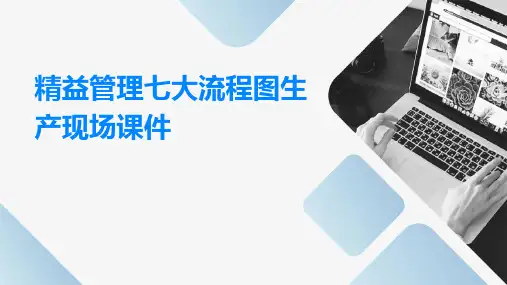

精益管理方式方法及工作思路精益管理方式及工作思路精益管理(Lean Management)是一种以流程优化、资源最大化利用和持续改善为核心的管理方法。
它的目标是通过消除浪费、提高效率和质量,实现企业的持续改善和卓越竞争力。
本文将介绍精益管理的基本原则、常用工具和实施步骤,以及在工作中如何应用精益管理的思路。
一、精益管理的基本原则精益管理的核心原则是以客户价值为导向,通过持续的改进来满足客户的需求。
以下是精益管理的基本原则:1. 价值流分析:通过理解价值流,即产品或服务从原材料采购到最终交付给客户的全过程,识别和分析其中的浪费,并持续改善流程,以提高价值创造能力和降低成本。
2. 浪费消除:浪费指的是任何不增加产品或服务价值的活动、物料或信息。
精益管理强调对浪费的彻底消除,包括运输、库存、运动、等待、过程中的不良品和不必要的加工等。
3. 价值流平衡:通过优化生产或服务过程中的各个环节,确保每个环节的节拍和产能相匹配,以避免过度生产或产能不足的情况。
4. 强调标准化工作:通过建立标准化工作程序和规范,确保工作的一致性和高质量,同时提供员工培训和支持,以便他们能够充分掌握和理解标准化工作的重要性和益处。
二、精益管理常用工具在实施精益管理时,常用的工具和技术有:1. 价值流图(Value Stream Mapping):价值流图是用于分析和改善价值流的工具,通过绘制价值流程图,可以清晰地展现原料采购、生产过程和交付给客户的全过程,进而找出其中的瓶颈和浪费,提出改善方案。
2. 5S方法:5S是一套整理、整顿、清扫、清洁和素养的方法,通过规范工作环境和操作规程,提高工作效率和质量,减少浪费。
3. Kaizen活动:Kaizen是指持续改善的活动,通过团队合作和日常小改进,不断优化工作流程,提高效率,降低成本。
4. 柏拉图图(Pareto Chart):柏拉图图用于分析问题的主要原因,帮助管理者更好地分配资源和制定改善计划。
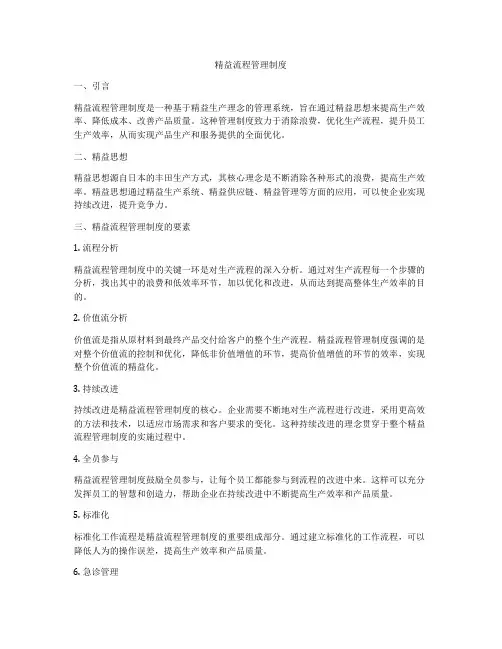
精益流程管理制度一、引言精益流程管理制度是一种基于精益生产理念的管理系统,旨在通过精益思想来提高生产效率、降低成本、改善产品质量。
这种管理制度致力于消除浪费,优化生产流程,提升员工生产效率,从而实现产品生产和服务提供的全面优化。
二、精益思想精益思想源自日本的丰田生产方式,其核心理念是不断消除各种形式的浪费,提高生产效率。
精益思想通过精益生产系统、精益供应链、精益管理等方面的应用,可以使企业实现持续改进,提升竞争力。
三、精益流程管理制度的要素1. 流程分析精益流程管理制度中的关键一环是对生产流程的深入分析。
通过对生产流程每一个步骤的分析,找出其中的浪费和低效率环节,加以优化和改进,从而达到提高整体生产效率的目的。
2. 价值流分析价值流是指从原材料到最终产品交付给客户的整个生产流程。
精益流程管理制度强调的是对整个价值流的控制和优化,降低非价值增值的环节,提高价值增值的环节的效率,实现整个价值流的精益化。
3. 持续改进持续改进是精益流程管理制度的核心。
企业需要不断地对生产流程进行改进,采用更高效的方法和技术,以适应市场需求和客户要求的变化。
这种持续改进的理念贯穿于整个精益流程管理制度的实施过程中。
4. 全员参与精益流程管理制度鼓励全员参与,让每个员工都能参与到流程的改进中来。
这样可以充分发挥员工的智慧和创造力,帮助企业在持续改进中不断提高生产效率和产品质量。
5. 标准化标准化工作流程是精益流程管理制度的重要组成部分。
通过建立标准化的工作流程,可以降低人为的操作误差,提高生产效率和产品质量。
6. 急诊管理急诊管理是精益流程管理制度中的一项重要措施。
企业在生产中遇到突发问题和故障时,需要迅速做出反应并采取行之有效的措施来解决问题,以减少生产损失。
四、精益流程管理制度的实施步骤1. 制定精益流程管理制度的目标和计划企业需要明确制定精益流程管理制度的目标和计划,以确定系统实施的方向和重点。
对现有的生产流程进行全面的调查和分析,找出其中的问题和瓶颈,为改进打下基础。
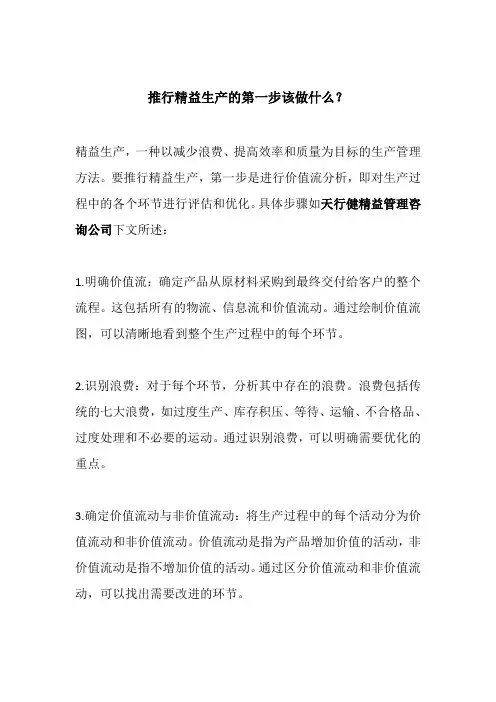
推行精益生产的第一步该做什么?
精益生产,一种以减少浪费、提高效率和质量为目标的生产管理方法。
要推行精益生产,第一步是进行价值流分析,即对生产过程中的各个环节进行评估和优化。
具体步骤如天行健精益管理咨询公司下文所述:
1.明确价值流:确定产品从原材料采购到最终交付给客户的整个流程。
这包括所有的物流、信息流和价值流动。
通过绘制价值流图,可以清晰地看到整个生产过程中的每个环节。
2.识别浪费:对于每个环节,分析其中存在的浪费。
浪费包括传统的七大浪费,如过度生产、库存积压、等待、运输、不合格品、过度处理和不必要的运动。
通过识别浪费,可以明确需要优化的重点。
3.确定价值流动与非价值流动:将生产过程中的每个活动分为价值流动和非价值流动。
价值流动是指为产品增加价值的活动,非价值流动是指不增加价值的活动。
通过区分价值流动和非价值流动,可以找出需要改进的环节。
4.寻找瓶颈:确定生产过程中的瓶颈环节,即限制整个生产流程的关键环节。
通过优化瓶颈环节,可以提高整个生产过程的效率。
5.制定改进计划:根据价值流分析的结果,制定改进计划。
改进计划应包括具体的措施和时间表。
在制定改进计划时,需要考虑到各个环节的优先级和可行性。
综上所述,通过价值流分析,可以找出生产过程中的瓶颈和浪费,并制定出改进计划。
这将为推行精益生产奠定基础,提高生产效率和质量,降低成本,为企业发展提供支持。
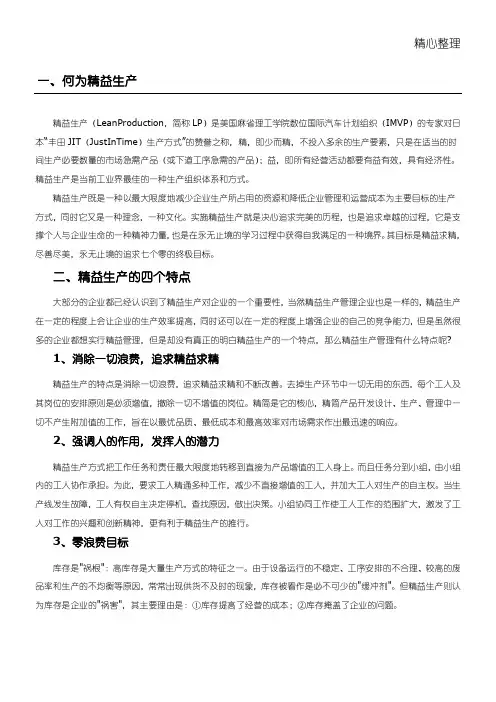
精心整理
精益生产(LeanProduction,简称LP)是美国麻省理工学院数位国际汽车计划组织(IMVP)的专家对日本“丰田JIT(JustInTime)生产方式”的赞誉之称,精,即少而精,不投入多余的生产要素,只是在适当的时间生产必要数量的市场急需产品(或下道工序急需的产品);益,即所有经营活动都要有益有效,具有经济性。
辨识精益生产的活动与方式、优化过程/流程、明确附加的价值、避免一切不附加价值的浪费、工序与操作作业标准化和准时交货。
2.连续改进:连续不断改进顾客要求的产品、过程与服务。
减少浪费。
其原理是实现使竞争对手吃惊的业绩改进和提升组织的精益能力。
3.顾客为中心:使企业的一切业务工作、业绩与质量的测度指标以顾客的满意作为目标和最终的评价标准。
4.完美无缺:以精益求精的工作精神和态度,利用改进各种资源的效率与效应的无穷机遇,以最低的成本、最高的质量和最短的交货期实现TCS,超越竞争对手,占领更多的市场份额,夺取竞争优势。
】,。
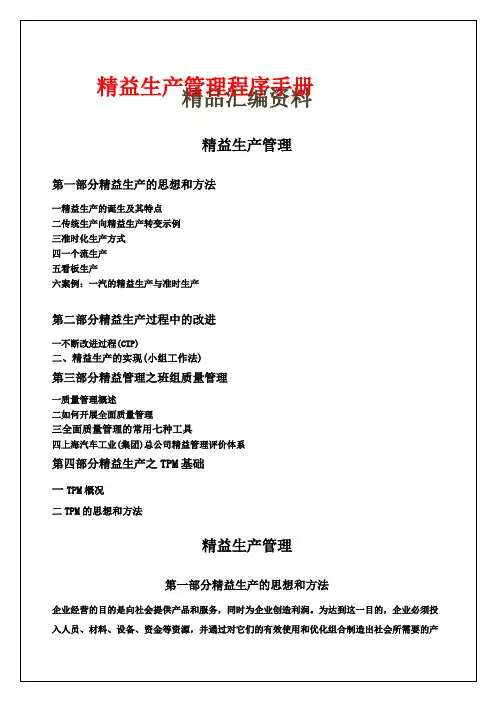
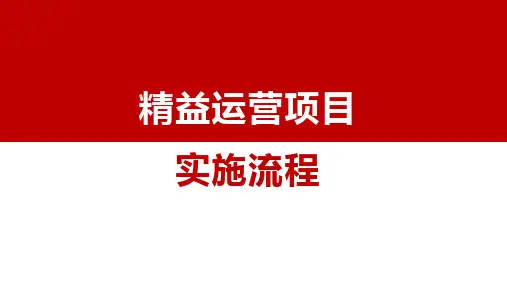
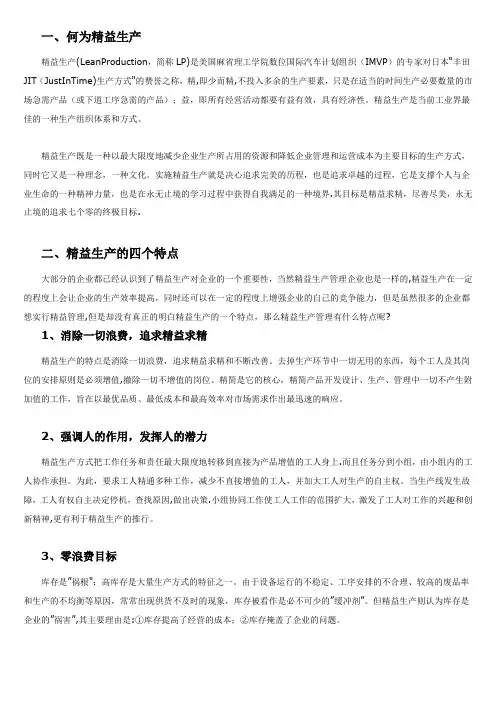
一、何为精益生产精益生产(LeanProduction,简称LP)是美国麻省理工学院数位国际汽车计划组织(IMVP)的专家对日本“丰田JIT(JustInTime)生产方式"的赞誉之称,精,即少而精,不投入多余的生产要素,只是在适当的时间生产必要数量的市场急需产品(或下道工序急需的产品);益,即所有经营活动都要有益有效,具有经济性。
精益生产是当前工业界最佳的一种生产组织体系和方式。
精益生产既是一种以最大限度地减少企业生产所占用的资源和降低企业管理和运营成本为主要目标的生产方式,同时它又是一种理念,一种文化。
实施精益生产就是决心追求完美的历程,也是追求卓越的过程,它是支撑个人与企业生命的一种精神力量,也是在永无止境的学习过程中获得自我满足的一种境界.其目标是精益求精,尽善尽美,永无止境的追求七个零的终极目标.二、精益生产的四个特点大部分的企业都已经认识到了精益生产对企业的一个重要性,当然精益生产管理企业也是一样的,精益生产在一定的程度上会让企业的生产效率提高,同时还可以在一定的程度上增强企业的自己的竞争能力,但是虽然很多的企业都想实行精益管理,但是却没有真正的明白精益生产的一个特点,那么精益生产管理有什么特点呢?1、消除一切浪费,追求精益求精精益生产的特点是消除一切浪费,追求精益求精和不断改善。
去掉生产环节中一切无用的东西,每个工人及其岗位的安排原则是必须增值,撤除一切不增值的岗位。
精简是它的核心,精简产品开发设计、生产、管理中一切不产生附加值的工作,旨在以最优品质、最低成本和最高效率对市场需求作出最迅速的响应。
2、强调人的作用,发挥人的潜力精益生产方式把工作任务和责任最大限度地转移到直接为产品增值的工人身上.而且任务分到小组,由小组内的工人协作承担。
为此,要求工人精通多种工作,减少不直接增值的工人,并加大工人对生产的自主权。
当生产线发生故障,工人有权自主决定停机,查找原因,做出决策.小组协同工作使工人工作的范围扩大,激发了工人对工作的兴趣和创新精神,更有利于精益生产的推行。
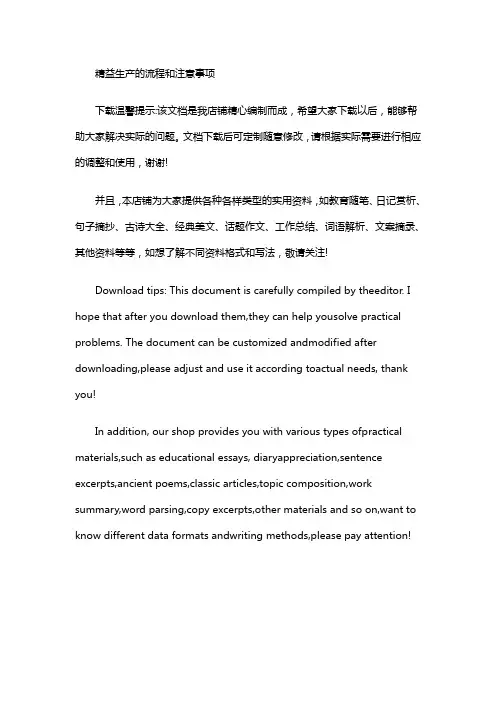
精益生产的流程和注意事项下载温馨提示:该文档是我店铺精心编制而成,希望大家下载以后,能够帮助大家解决实际的问题。
文档下载后可定制随意修改,请根据实际需要进行相应的调整和使用,谢谢!并且,本店铺为大家提供各种各样类型的实用资料,如教育随笔、日记赏析、句子摘抄、古诗大全、经典美文、话题作文、工作总结、词语解析、文案摘录、其他资料等等,如想了解不同资料格式和写法,敬请关注!Download tips: This document is carefully compiled by theeditor. I hope that after you download them,they can help yousolve practical problems. The document can be customized andmodified after downloading,please adjust and use it according toactual needs, thank you!In addition, our shop provides you with various types ofpractical materials,such as educational essays, diaryappreciation,sentence excerpts,ancient poems,classic articles,topic composition,work summary,word parsing,copy excerpts,other materials and so on,want to know different data formats andwriting methods,please pay attention!精益生产是一种注重消除浪费、提高效率和质量的生产方式。
它起源于日本,以丰田生产系统为代表,现在被全球许多企业采用。
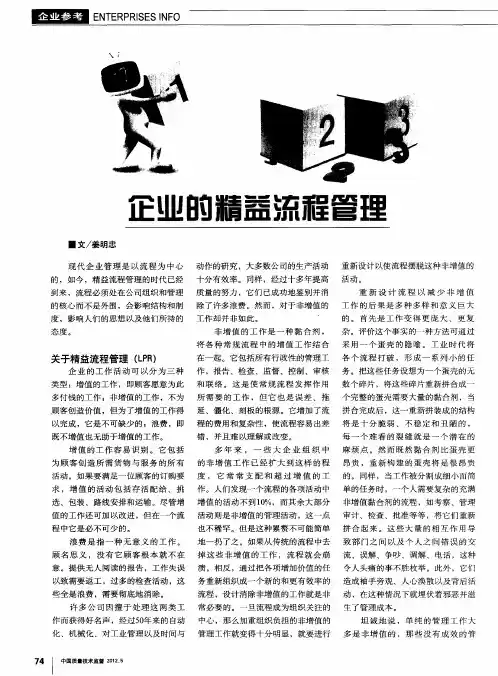
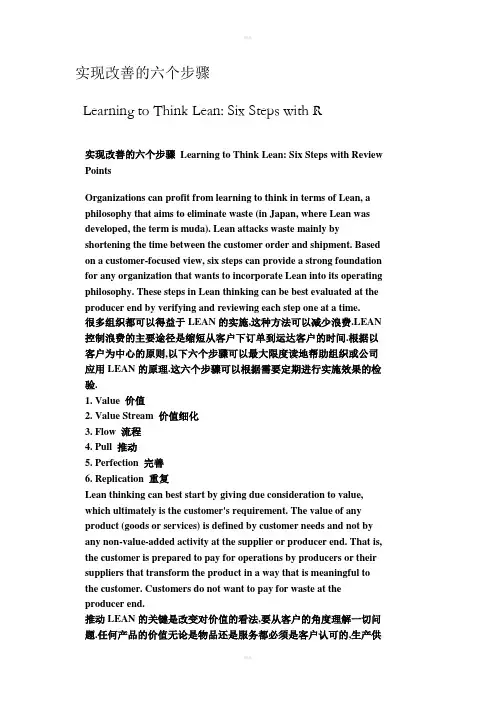
实现改善的六个步骤Learning to Think Lean: Six Steps with R实现改善的六个步骤Learning to Think Lean: Six Steps with Review PointsOrganizations can profit from learning to think in terms of Lean, a philosophy that aims to eliminate waste (in Japan, where Lean was developed, the term is muda). Lean attacks waste mainly by shortening the time between the customer order and shipment. Based on a customer-focused view, six steps can provide a strong foundation for any organization that wants to incorporate Lean into its operating philosophy. These steps in Lean thinking can be best evaluated at the producer end by verifying and reviewing each step one at a time.很多组织都可以得益于LEAN的实施,这种方法可以减少浪费.LEAN 控制浪费的主要途径是缩短从客户下订单到运达客户的时间.根据以客户为中心的原则,以下六个步骤可以最大限度读地帮助组织或公司应用LEAN的原理.这六个步骤可以根据需要定期进行实施效果的检验.1. Value 价值2. Value Stream 价值细化3. Flow 流程4. Pull 推动5. Perfection 完善6. Replication 重复Lean thinking can best start by giving due consideration to value, which ultimately is the customer's requirement. The value of any product (goods or services) is defined by customer needs and not by any non-value-added activity at the supplier or producer end. That is, the customer is prepared to pay for operations by producers or their suppliers that transform the product in a way that is meaningful to the customer. Customers do not want to pay for waste at the producer end.推动LEAN的关键是改变对价值的看法,要从客户的角度理解一切问题.任何产品的价值无论是物品还是服务都必须是客户认可的,生产供应方要避免一切没有价值的行为.客户只希望为自己需要的有意义的产品付钱,客户的钱不会花在生产者的浪费上.1. Value (Specifying)价值的定义Value is determined by the customers who want to buy the right product with the right capabilities at the right price. That is, the product must be "right" every time –from design to manufacture, from delivery to error-free operation. Lean companies work on making their processes right by eliminating waste –something no customer wants to pay for.价值是由客户决定的,客户愿意付钱购买物美价廉的东西.这些产品必须随时都满足客户,无论是设计还是制做,从安装到使用.应用LEAN 的公司是通过流程来控制浪费,以此来避免给客户带来损失.While linking the term "value" generally with customer requirements, the following questions can be asked to review the value for the customer as it relates to any specific product issue:当我们在考虑给客户带来的价值时,可以通过以下内容来特化价值的涵义.What is the problem that impacts the customer? 会给客户带来什么样的损失?What is the problem that the team is going to take action on? 我们在采取什么措施来克服这种损失?Why is the project so important that the organization should address it? 公司为什么要强调该项目的重要性?Why is the project being done? 为什么要完成该项目?Do all the stakeholders understand and agree to the problem and its impact on business? Do they all agree that fixing it is critical for the business? Do they all support the project? 是不是所有的股东都认识到该问题会给业务带来损失?他们都明白处理该问题的重要性吗?他们支持吗?Are the roles and responsibilities of the project team members clearly defined? 项目小组的责任和义务规定清楚了吗?Are the needs of the customers clearly identified? 客户需求搞清楚了吗?What's in it for the customers? How do they benefit? 给客户带来的直接利益是什么?What's in it for the business? How does the business benefit? 给公司业务带来的直接利益是什么?Were the key parameters or the most important thing to be fixed identified? 辨别改善的标准是什么?Does everyone describe what will be measured in the same way? 所有人都知道衡量改善的标准吗?Can the primary metric be manipulated? How does it drive the right behavior? 以前是怎样测量成败的指标的?What can go worse as a result of the project? 项目失败的潜在因素是什么?Where does the problem occur? Did the team identify it correctly? Did the team work on this particular issue to completion? 问题发生在哪里?如何发现的?项目小组的人员纠正那些问题了吗?What does success look like? How will success be quantified? 项目成功的标准是什么?怎样量化?2. Value Stream Mapping (Identifying)价值链的描述Once value is specified by the customers, the next Lean step is to identify the right process –a process that only adds value to the product, in other words, a waste-free process. The value stream for a product has three categories of activities:一旦客户认可了我们产品的价值,下一步就是要设计正确的流程.该流程只能给产品带来价值,或者说该流程应该是天衣无缝的.产品价值的实现一般有三个主要特征.1. Process steps that definitely create value: In any manufacturing process, the steps that are actually transforming the fit, form or function of the raw material, and bring it a step closer to the finished product.可以实现价值的流程步骤,任何制造流程都是为原材料转化成为终端成品而度身定做的.2. Process steps that create no value but are necessary, due to current state of the system: In any manufacturing process, activities like inspection, waiting and some transportation steps.没有直接价值但是必须的流程步骤,其存在是由于现有工艺或系统的限制:在任何制造流程中的一些动作,比如质量检验,等候,运输等步骤.3. Process steps that create no value and can be eliminated: Any activity that does not fall into the above two categories.While the parts of a process that create no value should be eliminated, any action or activity that is recognized asnon-value-added but currently necessary should be targeted for improvement. At this point a detailed process flow diagram should be generated for each product or product category. To ascertain which steps in the process are unnecessary, an intense questioning andre-examining method (Japanese term is kaikeku) is applied to every aspect of the process under consideration.不产生价值但是可以避免或控制的步骤:一旦发现任何没有价值但是由于现实条件不得不采取的步骤,都要作为下一步改善的目标.解决问题的方法是将该产品或产品类别的详细生产流程描绘出来,注明哪些是有待于改进的步骤.The review points at this stage are:需要经常检查的项目如下Does the team understand how the whole process works? 大家了解该流程的操作过程吗?Did the team manage to complete a detailed process flow diagram at this stage? 有没有把详细的流程图画出来?Did the team identify the waste in the process? 我们知道这个流程中产生浪费的步骤是在哪里?Did the team follow kaikeku –the radical improvement approach? 我们有改善计划吗?Were there any particular processes that did not support the customer need? 是否有些流程根本不能满足客户需求?Did the team make use of the knowledge and experience within the business to establish this? 我们是否应用大家的智慧和经验去解决?What constraints/flow problems exist in the process that are hurting the business? 该流程中有没有给业务带来损失的因素?Can the team quantify any difference in people, shifts and days causing hidden constraints/flow problems? 我们有没有量化流程中所存在的问题的手段?Does the team know the causes of the constraints/flow problems? 我们知道产生问题的原因吗?What impact on the business and customers are these constraints/flow problems causing? 当发生问题时对业务和客户产生怎样影响?When will the team have enough information/data about the issues that could be causing the problem? 何时我们可以有足够的数据来分析问题的所在?Does the information reveal anything new about the problem? 通过分析是否提示对问题有新的理解?Did the team understand the type of problem that is being faced? 我们知道自己面临问题的属性吗?Can the team state what the current performance of the process is? 我们可以描述清楚目前这个流程的实际能力吗?Is it clear yet what the business entitlement is from the process? 流程中那些可以影响业务的授权?Is there a need to go back and refine or change what was learned in the two value steps?有必要从新检查流程的步骤吗?3. Flow流程This Lean step focuses on rapid product flow (RPF). The specific process waste is identified at each stage of process flow and is eliminated. The team involved in Lean will physically walk the process and write down the distance the product travels during its process flow. The non-value-added distances are eliminated by physical layout change, which involves both human and machine. Factory floors are laid out in cells rather than in functional groupings, which reduces the distance the parts travel in the process flow.LEAN的步骤主要体现在快速提供产品的效率性.它可以随时发现流程中的浪费步骤并加以控制.项目小组的人员都必须身体力行,记录和测量产品在整个生产过程中的详细经过.通过动手调整布局来减少不必要的步骤,合理安排人力或必要的设备.工厂的布局更倾向于设计成小功能单元,而不是根据功能来划分.这样一来可以减少零部件的运输过程.It is at this point that the Lean enterprise implements 5S, a tool developed for reducing the slack hidden in manufacturing processes. 5S is the basis for Lean manufacturing and the foundation for adisciplined approach to the clean workplace. The five steps of 5S are (in Japanese and English):LEAN其实倾向于通过5S来实现管理.1. Seiri/Sort: Meaning sorting or segregating through the contents of the workplace and removing all unnecessary items.2. Seiton/Straighten: Meaning putting or arranging the necessary items in their place and providing easy access by clear identification.3. Seiso/Shine: Meaning cleaning everything, keeping it clean and using cleaning to inspect the workplace and equipment for defects.4. Seiketsu/Standardize: Meaning creating visual controls and guidelines for keeping the workplace organized, orderly and clean, in other words, maintaining the seiso, or shine.5. Shitsuke/Sustain: Meaning instituting training and discipline to ensure that everyone follows the 5S standards.Questions to be asked at this point are:How is the impact of customer demand on the process being translated or understood?Did the team physically visit the process to realize the process steps?Did the team identify the non-value-added distances traveled by parts?Did the team identify the movements and transportations?Have the hot spot(s) that are constraining the process been identified?What steps have been initiated to stabilize the constraints before the main improvement is made?Has the Lean team done enough to build 5S culture in the organization?Has the team taken the right steps to close the loop of each 5S step?4. PullThe benefits of Lean Steps 1, 2 and 3 allow a company to produce more than before and in a way that value is added at every step in the production process. The fourth Lean step can be directed towardeither removing excess capacity (inventory) or increasing the rate of pull.Lean, which identifies the seven deadly wastes as defects,over-production, transportations, waiting, inventory, motion and processing (or the acronym, DOTWIMP), lists inventory as a source of waste. Hence, producing anything that is not sold immediately and is waiting at any point of time for delivery is waste. A pull system, which on the production side is making a product at the same rate at which it is being sold, also is a waste-eliminating step. On the supply side, a pull system is flowing resources into a production process by replacing only what has been consumed.The review points here are:Did the Lean team define the sequence of operation?Did the team manage to achieve the balance of operation times?What can be put in place to support the customer supply needs?How will this be managed through the business?How will the internal inventory needs be managed?5. PerfectionThis Lean step emphasizes that continuous improvement has to be a part of the organization and is always possible. This is the desired state of any change in any environment. The organization should always try to achieve what is the perfect system for that kind of operation and should aim at continuously improving the present system. The word for this in Japanese is kaizen.Questions to be asked here are:Have all stakeholders acknowledged and accepted that the process has been improved?What process will be put in place to further improve the process?What risk is there that these causes will come back and disturb the process again?Did the team document the project in a form that anyone can understand?Has the team identified the next stage of continuous improvement?6. ReplicateThis Lean step is a confirmation of the system implemented and improvements achieved, and determining that these same system procedures, tools and techniques can be deployed anywhere in the operation or in any business process. The main benefit of this step is that any time spent in analysis is reduced.Now is the time to ask these questions:How will the team ensure that the business learns from its experience?Can this process improvement be replicated in other parts of the business?Is the control set true enough for a similar type of operation?Lean Kaizen is created with lean techniques. This DMAIC based lean kaizen methodology is for waste elimination in the daily activities. Kaizen workshop or event is one of key improvement tools used by the world-class companies likeToyota.Define (D)Define the scope and set objectives in projectcharter.Measure (M)Measure the current state process map suchas process steps, process time, lead time, WIP,etc from the work place or gemba.Analyze (A)Analyze current state, i.e. value and non-valueadded processes, bottleneck constraint andprocess efficiency.Improve (I)Improve process by designing a future statemap.Control (C)Control and hold the gain with metrics tomonitor results over time.How Lean Kaizen can add value and reduce waste?This paper titled "Value creation on service sectors through Kaizen" explains some fundamental issues in implementing Lean Kaizen on the shop floor.精益改善的DMAIC精益改善DMAIC这精益改善模型是由精益技术组成的。
精益部门的搭建流程精益部门的搭建流程包括以下几个步骤:1. 确定目标和愿景:明确精益部门的主要目标和愿景,这有助于指导整个搭建过程,并为后续的团队成员提供明确的方向。
2. 组织结构和人员配置:根据公司的规模和业务需求,确定精益部门的组织结构和人员配置。
这包括确定需要哪些职位,如精益经理、精益工程师、精益顾问等,并为其分配相应的职责。
3. 建立团队文化:在精益部门搭建过程中,建立一种鼓励创新、持续改进和团队合作的文化。
这种文化有助于提高员工的归属感和工作积极性,促进公司内部的交流与合作。
4. 制定培训计划:为了提高团队成员的技能和知识水平,需要制定有针对性的培训计划。
培训内容可以包括精益理念、精益工具和方法、项目管理等,以确保团队成员具备实现公司目标所需的能力。
5. 确定关键绩效指标(KPI):为了衡量精益部门的绩效,需要确定关键绩效指标,如成本降低、生产效率提高、质量改进等。
这些指标有助于监测团队进展,并及时调整和改进。
6. 建立沟通机制:建立有效的沟通机制,确保团队内部和公司其他部门之间的信息交流畅通。
这可以通过定期的会议、报告、共享文档等方式实现,以便及时分享最佳实践、解决问题、协调工作。
7. 持续改进:精益部门的核心是持续改进,因此搭建流程中要强调这一点。
团队成员应不断关注流程、产品和服务的改进机会,并采取相应的行动。
同时,应鼓励员工提出建议和意见,以便不断完善和优化工作方式。
8. 监控和评估:在整个搭建过程中,应对精益部门的进展进行持续的监控和评估。
这有助于及时发现问题、调整方向,并确保部门目标与公司目标保持一致。
定期的评估还可以激励团队成员努力实现目标,提高整体绩效。
9. 反馈和调整:在搭建过程中,应根据实际情况对计划进行适时的反馈和调整。
这可能涉及到组织结构、人员配置、培训计划等方面的问题。
通过及时的反馈和调整,可以确保精益部门的搭建更加顺畅、高效。
10. 总结经验教训:在搭建流程完成后,应对整个过程进行总结,分享经验教训。
精益化管理方案第1篇精益化管理方案一、项目背景随着市场竞争的加剧,企业对管理效率的要求越来越高。
为实现企业可持续发展,提高企业核心竞争力,降低成本,提高品质,缩短交货期,减少库存,本项目旨在引入精益化管理理念,对企业现有管理体系进行优化升级。
二、项目目标1. 提高管理效率,降低运营成本。
2. 提升产品质量,满足客户需求。
3. 缩短生产周期,提高交货速度。
4. 减少库存积压,降低库存成本。
5. 培养员工素质,提升企业核心竞争力。
三、项目实施方案1. 组织架构优化(1)设立精益化管理推进小组,负责项目策划、组织、实施和监控。
(2)明确各部门职责,优化业务流程,提高协同效率。
2. 管理体系构建(1)制定企业发展战略,明确企业目标。
(2)构建以客户需求为导向的产品研发体系。
(3)建立标准化、数据化的生产管理体系。
(4)完善供应链管理体系,提高采购和库存管理效率。
3. 流程优化(1)运用价值流分析,找出生产过程中的浪费,制定消除浪费的措施。
(2)优化生产布局,缩短物料运输距离。
(3)建立快速换线机制,提高生产线柔性。
4. 培训与文化建设(1)组织员工培训,提升员工技能和素质。
(2)推广精益化管理理念,形成企业共识。
(3)建立健全激励机制,鼓励员工积极参与精益化管理。
5. 持续改进(1)建立持续改进机制,定期对管理体系进行评审和优化。
(2)鼓励员工提出改进建议,发挥群众智慧。
(3)对改进成果进行总结和分享,促进企业内部经验交流。
四、项目实施步骤1. 项目启动:召开项目启动会,明确项目目标、范围、进度等。
2. 现状分析:对现有管理体系进行调研,找出存在的问题。
3. 方案制定:根据现状分析,制定具体的优化方案。
4. 方案实施:按照优化方案,分阶段、分步骤进行实施。
5. 效果评估:对实施效果进行评估,查找不足,制定改进措施。
6. 持续改进:建立持续改进机制,确保项目目标的实现。
五、项目风险与应对措施1. 风险:员工对精益化管理理念的抵触。
精益生产管理是一种强调持续改善、降低成本和提高效率的管理方法。
在这篇文章中,我将重点介绍精益生产管理的十大工具和实施步骤,以此来帮助你更好地理解这一管理方法。
一、价值流映射价值流映射是精益生产的关键工具之一,它可以帮助企业了解整个生产流程,找出生产中的浪费,从而进行优化和改进。
通过价值流映射,企业可以更好地理解价值创造的流程,识别出不必要的步骤和活动,从而精简生产流程,提高生产效率。
二、5S整理法5S整理法是指整理、整顿、清扫、清洁、素养的五个日语单词的头字母缩写。
这是一个用于管理和改善工作环境的工具,通过规范化工作环境,提高工作效率,减少浪费。
三、持续流生产持续流生产是指通过对生产流程进行优化,实现产品的快速、按需生产,减少库存和等待时间,提高生产效率。
通过持续流生产,企业可以更好地满足客户需求,降低成本,提高竞争力。
四、柔性生产柔性生产是指企业能够在不增加成本和不降低质量的前提下,快速对生产进行调整和变更,适应市场需求的能力。
通过柔性生产,企业可以更好地应对市场变化,提高生产灵活性和适应性。
五、标准化工作标准化工作是指对工作流程进行规范和标准化,以确保工作质量和效率。
通过标准化工作,企业可以更好地控制生产过程,减少变动和浪费,提高生产稳定性和质量。
六、JIT精益库存JIT精益库存是指“按需生产、零库存”的原则,通过精细的生产计划和供应链管理,实现产品的快速交付和零库存管理,从而减少库存成本和压力。
七、故障预防维护故障预防维护是指通过定期检查和维护设备,预防设备故障和停机时间,提高生产设备的稳定性和可靠性。
通过故障预防维护,企业可以降低维修成本,提高生产效率。
八、持续改善持续改善是精益生产的核心理念之一,通过不断地对生产流程进行分析和改进,实现持续的提升和创新。
通过持续改善,企业可以不断提高生产效率和质量,降低成本,提高竞争力。
九、价值链管理价值链管理是指对整个价值链进行优化和管理,从供应商到客户的整个生产和销售过程。